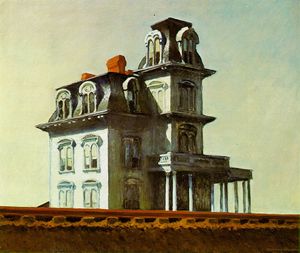Workhouses
 WORKHOUSES
WORKHOUSES
What was a workhouse?
The workhouse was 19th century England’s attempt to solve the problem of poverty.
England at this time was a thriving industrial centre, but there was still a huge growth in the population that meant thousands of people lived in poverty.
Hunger, disease and squalor were a part of everyday life for so many. The government decided to try to stop this and make the country a better place for the poor to live in.
Following on from the 1601 Poor Law Act, the 1834 Poor Law Act was passed. In it was the instruction to all unions to build a place in which all their poor could be housed.
Workhouses were originally meant to be places where the poor could work in return for food and board but the workhouse was not a place of comfort for those who were forced to enter them. Instead they were institutions of terror, in which inmates were harshly treated, put to work and made to suffer for being a burden. They were essential being punished for being poor, and the workhouse served as a deterrent to being poor.
What was it like in the workhouse ?
Life was meant to be much tougher inside the workhouse than outside, and the buildings themselves were deliberately grim & intimidating - they were designed to look like prisons. They were full of illness & disease brought about by over-crowding & the starvation diet. When you were admitted to the workhouse, you were stripped, searched, washed & had your hair cropped. You were made to wear a prison-style uniform. Women were at all times kept separate from the men, including their husbands. Children were kept separately from adults - even from their own parents.
History of the workhouse
The first legislation for providing relief to the poor were the Acts of 1572, 1597 & 1601. The 1601 POOR LAW ACT gave responsibility to local parishes for looking after very poor people, who were able to claim assistance from the parish's householders. Poor people were able to live at home when they were getting parish relief. With the 1834 POOR LAW AMENDMENT ACT people receiving help from the parish had to live in a workhouse & could no longer live at home. In return for parish relief, they would be made to work hard in the workhouse; which is how the term originated. The Act also allowed parishes to club together into unions responsible for building workhouses & for running them. In the next few years hundreds of workhouses were built at a typical cost to the union of £5,000. By 1926 there were 226,000 inmates & around 600 workhouses with an average population of about 400 inmates each. The 1929 LOCAL GOVERNMENT ACT abolished workhouses & their responsibilites were given to county borough & county councils.
Work in the workhouse
The work inmates were made to do was deliberately tedious. Householders objected to supporting idlers, so work was meant to keep people busy & to subsidise the cost of relief provided by the parish. Work was not always available & there was sometimes local hostility to the workhouse's cheap labour. After rising at 5am (in summer), an inmate worked 7-12am and 1-6pm; which is a 10 hour working day. Bed was 8pm. As well as gardening, cooking & sewing, there was corn milling, sack making, oakum picking (unravelling short lengths of rope) & crushing stone.
Food in the workhouse
Until 1842 all meals were conducted in silence without cutlery. All meals were basic and tasteless, following the same mundane weekly menu. These menus had been established in the 1834 Poor Law Amendment Act to ensure that the very basic levels of nutrition were met. H.M. Prisons official ration was 292oz of food per prisoner per week.In the Workhouse this ration was only 137oz (approx.) of food per inmate per week.
The staples were bread, cheese, gruel (thin oatmeal), soup, potatoes, and very rarely meat and bacon. Food was also stripped of everything that might have been attractive to inmates. Especially salt. And in the early workhouses of the 1830s inmates had not even been allowed cutlery.
Résumé:
Les "workhouses" ont été crées officielement en 1834 mais existaient déja depuis 1601.
Ces maisons permettaient au gens pauvres ou incapables de survivre eux même à leurs propres besoins de pouvoir être loger et se nourrir en échange d'un travaille.
Crées pour lutter contre pauvreté, ces institutions terririfiaient la population car les personnes pauvres étaient forcées d'y rentrer. La vie y était très rude et les conditions de travaille extrèmes. Les occupants traités plus comme des "prisonniers" faisaient des journées de 10 heures et avaient beaucoup de corvées. Les conditions de vie étaient rudimentaires. La nourriture était réduite au minimum. Le régime de base était de mise et les proportions les plus réduites possibles.
A leur arrivée, les familles étaient séparées. D'un coté les hommes, de l'autre les femmes et enfin les enfants. Ces maisons éffayaient beaucoup la population et tout le monde redoutait d'y être envoyé.





 Biography:
Biography:  s, fresh direct vision, and an undertone of intense feeling. For the first time, they were admitted to the big exhibitions, won prizes, and attracted attention from critics.
s, fresh direct vision, and an undertone of intense feeling. For the first time, they were admitted to the big exhibitions, won prizes, and attracted attention from critics.  His works convey a particular mood, often characterized by isolation, detachment, and melancholy. Hopper's subject matter were: the city, the small town and the country. His city scenes were concerned not with the busy life of streets and crowds, but with the city itself, a huge complex of steel, glass… When one or two women do appear, they seem to embody the loneliness of so many city dwellers. Light plays an essential role.
His works convey a particular mood, often characterized by isolation, detachment, and melancholy. Hopper's subject matter were: the city, the small town and the country. His city scenes were concerned not with the busy life of streets and crowds, but with the city itself, a huge complex of steel, glass… When one or two women do appear, they seem to embody the loneliness of so many city dwellers. Light plays an essential role.  Often his city interiors at night are seen through windows. This interplay of lights of differing colours and intensities turns familiar scenes into pictorial dramas. His landscapes have a crystalline clarity and often a poignant sense of solitude and stillness. It was this combination of love and revealing truth that gave his portrait of contemporary America its depth and intensity.
Often his city interiors at night are seen through windows. This interplay of lights of differing colours and intensities turns familiar scenes into pictorial dramas. His landscapes have a crystalline clarity and often a poignant sense of solitude and stillness. It was this combination of love and revealing truth that gave his portrait of contemporary America its depth and intensity.  his great love and the area of his chief influence. He created a world of loneliness, isolation and quiet anguish that we call Hopperesque. Hopper's influence became, consciously or unconsciously, pervasive. Hitchcock's Psycho (1960) was a crucial point where the sinister verticality of Hopper's mansard-roofed house in his first acclaimed painting House by the Railroad (1925), was combined with the unprepossessing horizontality of his numerous paintings of motels. Not surprisingly Hopper has been a major influence on the road movie.
his great love and the area of his chief influence. He created a world of loneliness, isolation and quiet anguish that we call Hopperesque. Hopper's influence became, consciously or unconsciously, pervasive. Hitchcock's Psycho (1960) was a crucial point where the sinister verticality of Hopper's mansard-roofed house in his first acclaimed painting House by the Railroad (1925), was combined with the unprepossessing horizontality of his numerous paintings of motels. Not surprisingly Hopper has been a major influence on the road movie. 
